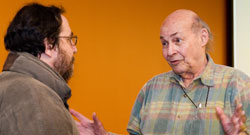The brain: A little cloud of computers

Marvin Minsky (right) drew a standing-room-only crowd for his lecture on artificial intelligence research.
Rob Maguire
Something is rotten in the state of artificial intelligence research, according to Marvin Minsky, a veritable AI legend. The professor from the Massachusetts Institute of Technology spoke to a standing-room-only crowd on March 8.
“There’s something wrong with my field,” he said. “I’m afraid I don’t see much evolution in the individuals of my profession.”
In the sciences, Minsky said, progress is ensured by constantly exposing your theories to the scrutiny of your peers. If something doesn’t work, you go back to the drawing board. “In AI, if you find that something is wrong with your theory, you shut up,” he said.
Solving the hard problems of AI is crucial to the ongoing survival of our species. Overpopulation, an aging workforce and longer lives are all putting increased pressure on our stretched resources.
Minsky pointed out that since 1950, average life expectancy has been growing one year for each four. Soon we will need to turn to machines to handle the mundane business of supplying society’s needs.
“The trouble is, we don’t have machines that can do unskilled labour,” he said.
Minsky outlined several key areas where AI research is lagging behind, and suggested that a more holistic, top-down approach to the science would likely yield better results.
“In the 1960s and ’70s, a lot of us had the idea that thinking is the manipulating of data structures of various sorts, and we tried to find the right kind of abstractions and operations to represent these phenomena,” he said.
“Instead of attacking the problem in a common-sense way, asking what kind of processes might be going on to produce these results, people started to be jealous of physicists. They became impatient with heuristic programming. They wished to be like Newton and discover a few general laws.”
But having a compact set of rules doesn’t ensure that you’re going to solve anything. He gave the example of mathematics, where a few axioms have yielded a number of unsolved problems.
“The important thing in a computer is not how a transistor works, but how two transistors can be connected to form a flip-flop that functions independently of how the transistor works,” he said.
The solution to the difficult challenges facing AI will not come from a handful of low-level rules, but through a greater understanding of the high-level processes that give rise to consciousness.
“Think of the brain as a cloud of hundreds of little computers. In each mental state, you turn some of them on and some of them off. Maybe the same thing is true also of high-level functions.”